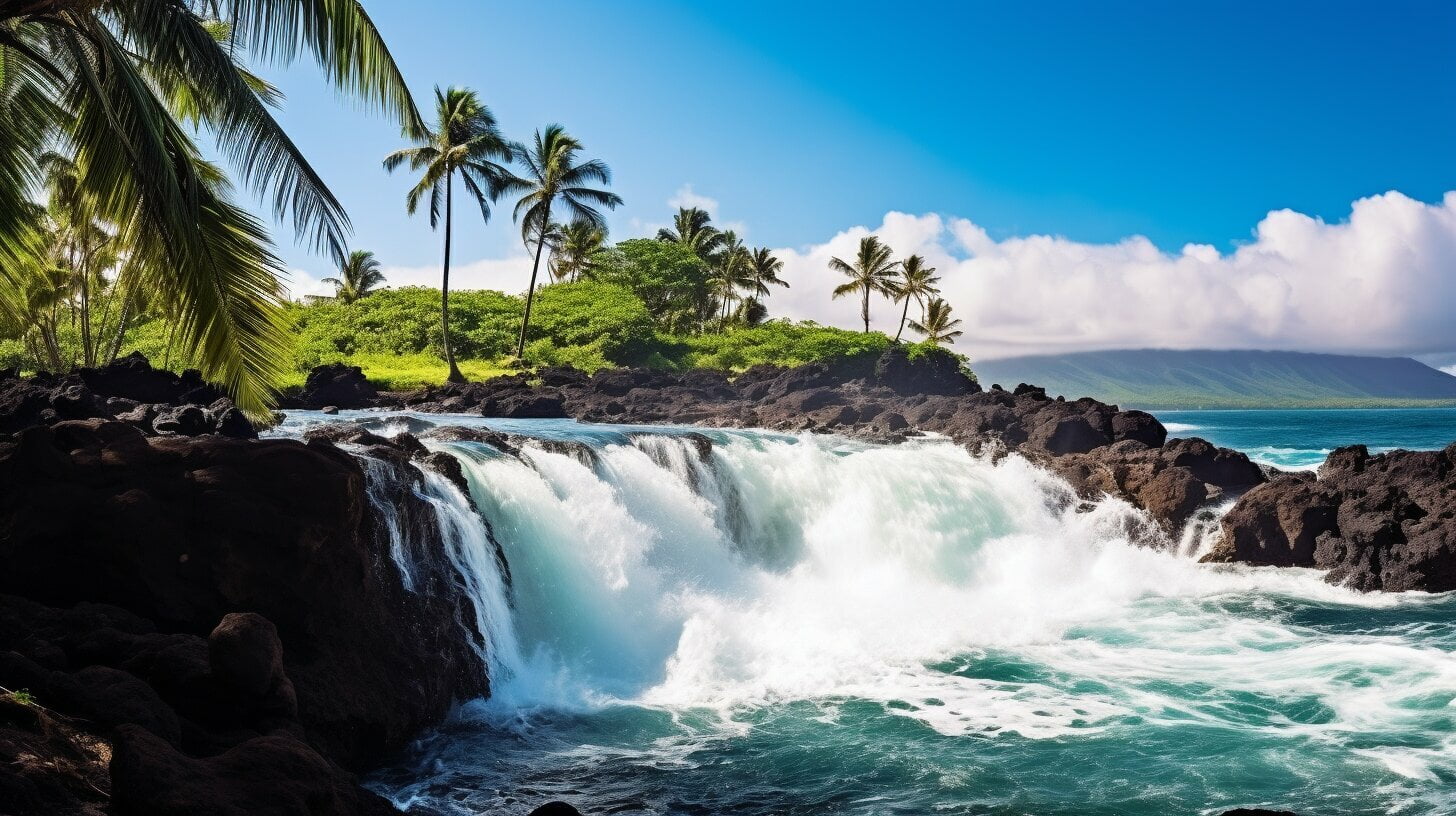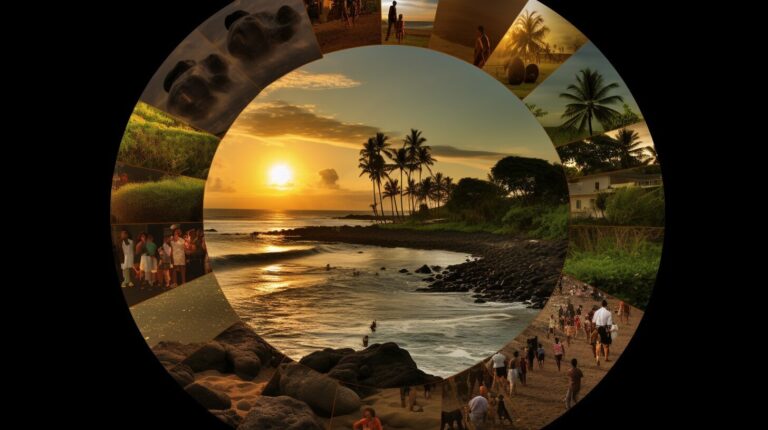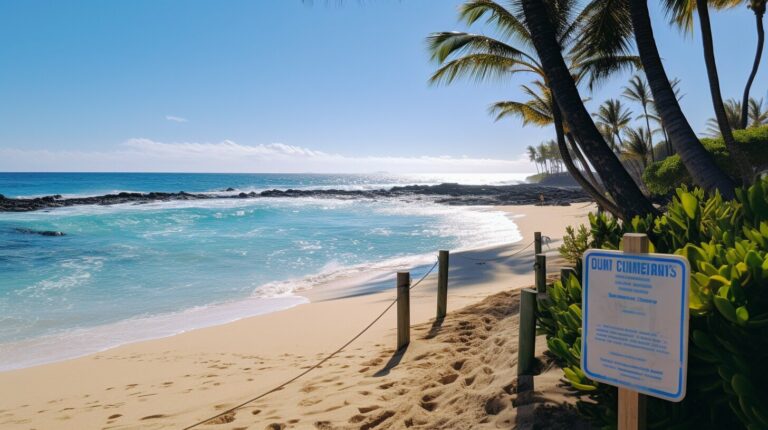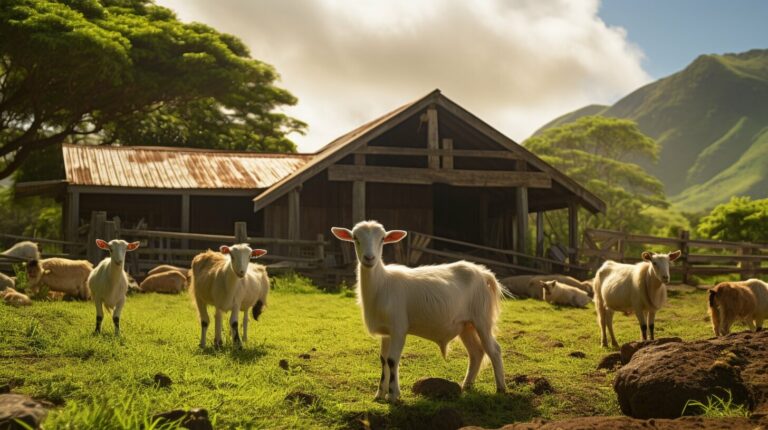🌋 Unveiling the Majestic Big Island: A Geological Marvel of Hawaii 🌴
Welcome to the Big Island of Hawaii, where diverse terrain and breathtaking landscapes await you. As the largest of Hawaii’s islands, the Big Island boasts an array of geographical features that have been shaped by volcanic activity over millions of years. From stunning coastlines to towering mountains, this island offers something for everyone.
Whether you’re a nature enthusiast, adventure seeker or just someone looking to relax and unwind amidst stunning natural beauty, the Big Island has it all. In this article, we will explore the unique geography of the Big Island, including its volcanic activity, landforms, climate, flora and fauna, and natural attractions.
Key Takeaways:
- The Big Island of Hawaii boasts an array of geographical features shaped by volcanic activity.
- From stunning coastlines to towering mountains, the island offers something for everyone.
- In this article, we will explore the island’s diverse geography, including its volcanic activity, landforms, climate, flora and fauna, and natural attractions.
Geographical Features of Big Island
The Big Island of Hawaii boasts a diverse set of geographical features that make it a unique destination for travelers. From its active volcanoes to its stunning coastlines and ancient valleys, the island’s natural wonders are truly awe-inspiring.
The most prominent geological feature of the Big Island is its volcanic activity. The island is home to five volcanoes, including Kilauea, the world’s most active volcano. These volcanoes have created a range of landforms such as craters, cinder cones, and lava tubes.
The volcanic activity on the island has also created stunning mountains, including Mauna Kea and Mauna Loa, both of which stand over 13,000 feet tall. These mountains are the result of millions of years of eruptions and lava flows.

In addition to its volcanoes and mountains, Big Island has a diverse range of coastal areas. The island’s western coast features black sand beaches, while the eastern coast is known for its green sand beaches. The southern coast, on the other hand, boasts rugged cliff formations and sea caves.
The island also has several valleys, such as Waipio Valley and Pololu Valley. These valleys were formed by erosion and are home to lush vegetation, waterfalls, and streams.
Overall, the geographical features of Big Island make it a remarkable destination for travelers seeking to experience the raw, natural beauty of Hawaii.
Volcanic Activity in Big Island
The Big Island is home to some of the most active volcanoes on Earth. The island is situated along the Pacific Ring of Fire, an area known for its high volcanic and seismic activity. The volcanoes on the Big Island have been erupting for millions of years, shaping the island’s geography and providing a unique natural spectacle for visitors.
The most active volcano on the island is Kilauea, which has been erupting continuously since 1983. It is one of the world’s most active volcanoes and has been known to spew lava flows that can travel up to 10 miles from the vent. The volcano is located within Hawaii Volcanoes National Park, which attracts millions of visitors each year.
The other active volcano on the island is Mauna Loa, which is the largest volcano on earth by volume. Although it has not erupted since 1984, it is still considered an active volcano. Mauna Loa has a broad, gently sloping caldera and is a popular destination for hikers.
The volcanic activity on the Big Island has had a significant impact on the island’s geography. The lava flows have created vast landscapes of hardened lava rock that are both beautiful and eerie. The volcanic ash and gases have also added nutrients to the soil, creating a fertile environment that supports a diverse range of plant and animal life.

The volcanic activity on the Big Island is a powerful reminder of the natural forces that shape our planet. It is a testament to the resilience of life in the face of adversity, and a testament to the ever-changing nature of our world.
Despite the risks associated with volcanic activity, many visitors are drawn to the Big Island to witness the raw power and beauty of the volcanoes. Hawaii Volcanoes National Park offers a range of activities for visitors, including hiking trails, scenic drives, and ranger-led tours. Visitors can also take helicopter tours to observe the volcanoes and lava flows from above.
Landforms in Big Island
The unique geography of the Big Island has given rise to a diverse range of landforms that are awe-inspiring to behold. From the rugged coastlines to the expansive lava fields, the island is a fascinating study in natural wonders.
One of the most striking features of the island is the presence of lava fields, which cover large portions of the landscape. These fields were created by the eruptions of the island’s many volcanoes over the centuries and are still being added to today. The black and barren fields offer a stark contrast to the lush greenery that surrounds them and are a reminder of the island’s fiery past.
The cliffs of the Big Island are also a sight to behold, rising up to meet the waves of the Pacific Ocean. The cliffs are a result of the island’s volcanic activity and offer stunning views of the ocean and surrounding landscape. Visitors can see these magnificent cliffs at locations like the Waipi’o Valley Lookout, which offers panoramic views of the valley and the ocean beyond.
Another fascinating landform found on the island is the ancient valleys, which were created by the erosion of the island’s volcanic mountains over millions of years. These valleys offer a glimpse into the island’s geologic past and are home to a variety of plant and animal life. One of the most famous valleys is the Pololu Valley, which can be accessed via a hike that offers breathtaking views of the valley and surrounding cliffs.
The unique landforms of the Big Island offer a glimpse into the island’s turbulent past and provide a visual feast for visitors. From the dark, barren lava fields to the towering cliffs and ancient valleys, the island’s topography is a reminder of the power and beauty of nature.

Climate of Big Island
The Big Island boasts of a unique climate pattern that sets it apart from the other islands in Hawaii. Due to its varying topography and location, the island experiences a range of microclimates that influence the weather and temperature throughout the year.
At the lower elevations, the Big Island features a tropical climate with hot and humid conditions. The coastal areas experience minimal temperature changes throughout the year with average temperatures ranging between 75°F to 85°F. However, the eastern side of the island, which is known as the wet side, receives a significant amount of rainfall due to the trade winds. This side of the island is home to the lush rainforests with cascading waterfalls, streams, and wet caves.
In contrast, the western side of the island, known as the dry side, is relatively arid with little rainfall and more sunshine. The northern areas of the island experience cooler temperatures due to the altitude and the proximity to the ocean.
The Big Island’s unique climate patterns are influenced by the island’s geography, including the mountain ranges, valleys, and volcanic activity. The island’s peaks, such as Mauna Kea and Mauna Loa, are often snow-capped and can drop to freezing temperatures, even during summer.

The Big Island’s climate patterns offer a range of activities and experiences for visitors to enjoy. Whether it’s lounging on one of the many beaches, hiking through lush rainforests, or exploring the snow-capped mountains, the island’s diverse topography and climate make it an excellent destination for all seasons.
Flora and Fauna of Big Island
The diverse geography of the Big Island is home to a unique array of plant and animal life. The island’s isolation from the mainland has allowed for the development of numerous endemic species that cannot be found anywhere else in the world.
The tropical climate of the island, combined with its variety of ecosystems, has resulted in a rich and vibrant flora that includes over 750 species of flowering plants and 150 species of ferns. Among the most significant are the ‘ōhi’a lehua tree, which is sacred to Hawaiian culture, and the fragrant yellow hibiscus, the state flower of Hawaii.
| Endemic Species | Description |
|---|---|
| Hawaiian Honeycreepers | A colorful group of birds with unique bill shapes and pigmentation found only in Hawaii. |
| Nene Goose | The state bird of Hawaii, this endangered species is the world’s rarest goose. |
| Hawaiian Monk Seal | An endangered species of seal found only in the Hawaiian Islands, with a population of around 1,400-1,500 individuals. |
The Big Island is also home to several wildlife reserves, including the Hawaii Volcanoes National Park, which is home to several endangered species such as the Hawaiian goose and the Hawaiian hawk. Visitors can also explore the unique underwater world of the island’s coral reefs, which are home to over 500 species of fish and a variety of sea turtles.
With over 20 state parks and numerous hiking trails, visitors to the Big Island can experience the island’s unique flora and fauna up close. Whether exploring the lush rainforests or the stark lava fields, the diverse geography of the Big Island offers a captivating experience for nature lovers.

Natural Attractions in Big Island
The Big Island’s diverse geography creates a stunning array of natural attractions that are a must-visit for any traveler. From breathtaking beaches to lush forests, the island’s topography offers a unique experience for anyone looking to connect with nature.
Hawaii Volcanoes National Park
Perhaps the most famous natural attraction on the Big Island is Hawaii Volcanoes National Park. The park boasts two active volcanoes, Kīlauea and Mauna Loa, which have been shaping the island’s geography for thousands of years. Visitors can explore the park’s hiking trails, volcanic craters, and lava tubes. Don’t forget to catch a glimpse of the glowing lava at night!

Waipi’o Valley
Waipi’o Valley is a lush, green valley that is one of the most beautiful spots on the Big Island. Located on the island’s northeast coast, the valley is surrounded by steep cliffs and is home to a series of waterfalls. Visitors can explore the valley on foot, by horseback, or even by ATV.
Akaka Falls State Park
Akaka Falls State Park is a must-visit for anyone who loves waterfalls. The park is home to two stunning waterfalls, including the 442-foot-tall Akaka Falls. Visitors can take a short hike through the park to view the falls and the lush tropical vegetation.
Mauna Kea
Mauna Kea is a dormant volcano that stands at over 13,000 feet tall. It is the highest point in Hawaii and offers some of the best stargazing in the world. Visitors can take a guided tour to the summit to learn about the cultural and ecological significance of the mountain.
These are just a few of the many natural attractions that the Big Island has to offer. From black sand beaches to ancient lava fields, the island’s geography is truly one of a kind.
Conclusion
The Big Island of Hawaii is a geological wonder, shaped by millions of years of volcanic activity and unique geographical features. Its diverse terrain offers visitors a mesmerizing experience, from towering mountains to lush valleys, lava fields to pristine beaches.
The island’s active volcanoes serve as a reminder of the constant changes occurring in its landscape, with recent eruptions leaving behind new natural formations for visitors to explore. The Big Island’s climate is also incredibly varied, with microclimates offering a range of weather patterns and unique vegetation.
Whether it’s exploring the island’s natural attractions, hiking in its national parks, or simply taking in the stunning vistas, the Big Island is a destination unlike any other. Its flora and fauna are equally diverse, with endemic species found nowhere else in the world.
The Big Island’s unique geography creates an unparalleled experience for visitors, and its natural beauty is a testament to the power and beauty of the natural world. With so much to see and do, exploring the Big Island’s geography is an adventure that visitors won’t soon forget.







